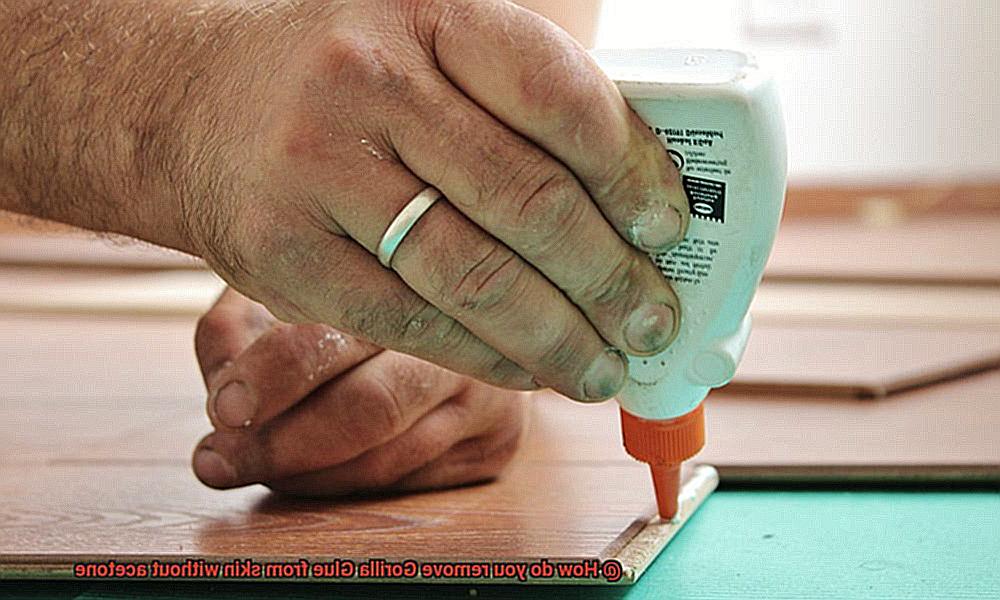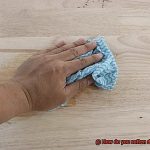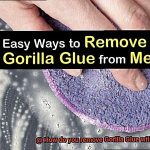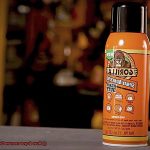We’ve all been there – a tiny slip-up with Gorilla Glue and suddenly, our fingers are stuck together like a stubborn puzzle. While acetone is usually the go-to solution for this sticky situation, it’s not always on hand or suitable for everyone’s skin. But fret not. There are alternative methods that can save your skin from this adhesive nightmare without the need for acetone. In this blog post, we’ll explore some clever and effective techniques to liberate your skin from the clutches of Gorilla Glue – naturally and safely. So let’s dive in and discover how to bid farewell to unexpected bonding mishaps with Gorilla Glue.
Soap and Warm Water: An Easy Method to Remove Gorilla Glue from Skin
Contents
- 1 Soap and Warm Water: An Easy Method to Remove Gorilla Glue from Skin
- 2 Olive Oil or Coconut Oil: Natural Lubricants That Help Dissolve the Glue
- 3 Petroleum Jelly or Baby Oil: Softening and Loosening Adhesive Properties of Gorilla Glue
- 4 Vinegar or Lemon Juice: Acidic Substances That Break Down the Glue
- 5 Natural Remedies for Removing Gorilla Glue from Skin
- 6 Tips for Safely Removing Gorilla Glue from Skin without Acetone
- 7 When to Seek Professional Advice Regarding Removal of Gorilla Glue from Skin
- 8 Conclusion
When it comes to removing Gorilla Glue from your skin, you might think that acetone is your only option. However, there is a simple and accessible alternative that involves using soap and warm water. This method can be just as effective, without the potential harshness of acetone on your skin.
The first step in this method is to wet the affected area with warm water. This helps to loosen the glue and make it easier to remove. The warmth of the water aids in breaking down the adhesive properties of the glue, making it more pliable.
Once the area is wet, it’s time to grab a mild soap. Ensure that you use a soap that is gentle on the skin, as harsh soaps can cause irritation. Apply a generous amount of soap to the affected area and begin rubbing it in using gentle circular motions. This motion helps to break down the adhesive properties of the glue further.
Don’t rush this process; take your time and thoroughly rub the soap into the glue for a few minutes. Make sure to cover all areas that are covered with glue to ensure effective removal. The gentle circular motions work to loosen the glue from your skin, allowing it to be easily washed away.
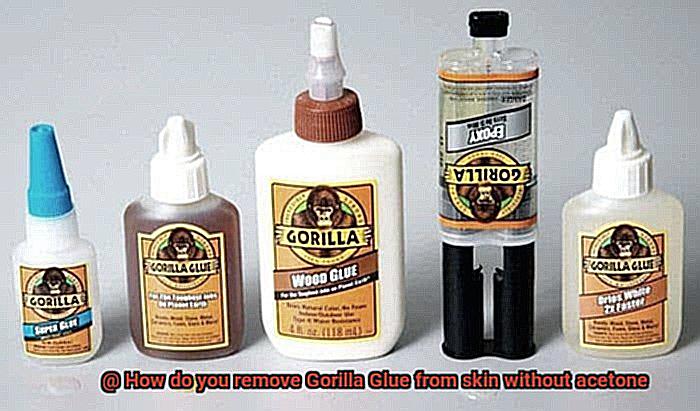
After you’ve thoroughly rubbed the soap into the glue, it’s time to rinse. Rinse the area with warm water, ensuring that all traces of soap and glue are washed away. This final step removes any remaining residue and leaves your skin clean and free from Gorilla Glue.
It’s important to note that this method may not completely remove all traces of Gorilla Glue from your skin, especially if it has dried or hardened. In such cases, additional methods may be needed.
Alternative methods include using oils like olive oil or coconut oil to soften and dissolve the glue. These oils work by breaking down the adhesive properties of the glue, making it easier to remove. Simply apply a small amount of oil to the affected area and gently rub it in, allowing it to sit for a few minutes before rinsing with warm water.
Another option is to use petroleum jelly or baby oil, which can also help break down the adhesive properties of the glue. Apply a generous amount to the affected area and let it sit for a few minutes before rinsing with warm water.
If you prefer a more acidic approach, vinegar or lemon juice can be effective in dissolving the glue. These acidic substances help to break down the adhesive properties of the glue, making it easier to remove. Simply apply a small amount of vinegar or lemon juice to the affected area, let it sit for a few minutes, and then rinse with warm water.
Regardless of the method chosen, it’s important to be patient and gentle during the removal process. Avoid using excessive force or harsh scrubbing, as this can irritate the skin and potentially cause damage. If any discomfort or irritation occurs during the removal process, it is recommended to stop immediately and consult a healthcare professional.
Olive Oil or Coconut Oil: Natural Lubricants That Help Dissolve the Glue
When it comes to finding a natural solution to dissolve the sticky situation caused by Gorilla Glue, two popular options come to mind: olive oil and coconut oil. These household staples not only offer a delicious addition to your cooking but also possess unique properties that can break down the adhesive properties of the glue, making it easier to remove without resorting to harsh chemicals like acetone.
Let’s first explore the wonders of olive oil. Known for its moisturizing and lubricating properties, this versatile oil contains fatty acids that work their magic by loosening the grip of the glue. Not only does olive oil help dissolve the glue, but it also provides a soothing effect on the skin, alleviating any irritation caused by the adhesive.
Coconut oil, on the other hand, is a true multitasker. Not only does it serve as a popular natural remedy for various skin issues, but it also boasts antimicrobial and anti-inflammatory properties that can help soothe the skin while effectively breaking down the glue. With its low molecular weight, coconut oil has the ability to penetrate deep into the glue, softening it for easy removal.
To utilize the power of these natural lubricants, start by generously applying either olive oil or coconut oil onto the affected area. Massage it gently into the glue, allowing it to penetrate and work its way through the adhesive. After a few minutes of letting the oil work its magic, you can attempt to gently peel or rub off the softened glue. Remember to exercise caution and avoid applying excessive pressure or force, as this could potentially cause skin irritation or damage.
If the glue proves stubborn and resists removal, don’t lose hope. Simply repeat the process by reapplying more oil and giving it additional time to soak in. Patience is key in fully dissolving and removing the glue.
Once you have successfully removed the adhesive, wash the area with mild soap and water to eliminate any residue left behind by the oil.
It’s important to keep in mind that while olive oil and coconut oil are effective natural alternatives for removing Gorilla Glue from the skin, they may not work as quickly or efficiently as acetone. Multiple applications and a bit of patience may be necessary to achieve complete dissolution of the glue.
Additionally, it is always advisable to perform a patch test before using any new product or substance on your skin, especially if you have sensitive skin or allergies.
Petroleum Jelly or Baby Oil: Softening and Loosening Adhesive Properties of Gorilla Glue
Softening and loosening the adhesive properties of Gorilla Glue can be achieved using two popular options: petroleum jelly and baby oil. These alternatives offer a more gentle approach compared to harsh solvents like acetone, making them ideal for individuals with sensitive skin or those who prefer natural alternatives. Let’s delve into the properties of petroleum jelly and baby oil, discussing their advantages and disadvantages in removing Gorilla Glue.
Petroleum jelly, also known as petrolatum, is derived from petroleum and has been used for skincare purposes for a long time. With its moisturizing and protective properties, it is an excellent choice for softening Gorilla Glue. When applied to the affected area, petroleum jelly effectively breaks down the adhesive, making it easier to remove. Its thick consistency ensures that the area stays moisturized during the removal process, preventing any potential skin irritation.
On the other hand, baby oil is a mineral oil-based product commonly used for baby massage and skincare. It is known for its gentle and soothing effects on the skin. Baby oil works similarly to petroleum jelly by softening the adhesive, allowing for effortless removal. Its lightweight texture makes it easy to spread onto the affected area.
The advantages of petroleum jelly include its long-lasting moisturizing effect and its ability to create a protective barrier on the skin. This is particularly beneficial when dealing with larger areas of Gorilla Glue or when repeated applications are necessary. Additionally, petroleum jelly is readily available in most households and is relatively inexpensive.
In contrast, baby oil provides a lightweight and non-greasy alternative. It absorbs quickly into the skin, leaving behind a smooth finish. This can be advantageous when dealing with smaller areas or when a less sticky residue is desired after removal.
However, it’s important to note that both petroleum jelly and baby oil may require multiple applications and some gentle rubbing or peeling to fully remove Gorilla Glue. The effectiveness may also depend on the amount of glue and how well it has adhered to the skin.
To safely and effectively remove Gorilla Glue using petroleum jelly or baby oil, follow these steps:
- Apply a generous amount of petroleum jelly or baby oil directly onto the affected area.
- Allow the product to sit on the adhesive for a few minutes, allowing it to penetrate and soften the glue.
- Gently rub or massage the area using circular motions to further break down the adhesive.
- Repeat the process as needed until all traces of Gorilla Glue are removed.
- Wash the area with mild soap and warm water to remove any residue left behind by the petroleum jelly or baby oil.
Vinegar or Lemon Juice: Acidic Substances That Break Down the Glue
When it comes to removing stubborn glue from our skin, vinegar and lemon juice are two acidic substances that come to the rescue. These powerful agents work by breaking down the adhesive properties of the glue, making it easier to remove. However, it’s important to note that while vinegar and lemon juice can be effective, they may not work as quickly or efficiently as acetone. Patience and multiple applications may be needed to dissolve the glue completely.
So how do vinegar and lemon juice work their magic? Vinegar contains acetic acid, while lemon juice contains citric acid. Both acids have the power to weaken the bonds of the glue, causing it to lose its stickiness. This natural reaction between the acid and the adhesive properties of the glue is what facilitates its breakdown.
To use vinegar or lemon juice for glue removal, soak a cloth or cotton ball in either substance and apply it directly to the affected area. Gently rub or massage the glue until it starts to loosen. Remember, avoid scrubbing or forcefully pulling at the glue to prevent skin irritation or damage. Instead, be patient and gentle in your approach.
It’s worth mentioning that everyone’s skin reacts differently, so it’s advisable to perform a patch test before using vinegar or lemon juice on a larger area of skin. Apply a small amount of the substance on a small patch of skin and wait for any adverse reactions before proceeding with full application.
After successfully removing the glue, rinse the area thoroughly with water and pat dry. To soothe any potential irritation caused by the adhesive, apply a moisturizer or soothing ointment. This will help restore moisture and promote healing.
However, if vinegar or lemon juice doesn’t fully remove the glue or if you experience any discomfort or adverse reactions, it’s recommended to seek professional medical advice for safe and effective glue removal.
Natural Remedies for Removing Gorilla Glue from Skin
When it comes to removing Gorilla Glue from skin, many people prefer to avoid harsh chemicals like acetone and opt for natural remedies instead. Fortunately, there are several effective options that can be easily accessed at home or in stores.
One popular natural remedy is vegetable oil. This oil contains fatty acids that can help dissolve the adhesive properties of Gorilla Glue. To use this method, simply apply a generous amount of vegetable oil to the affected area and gently massage it into the glue. Let it sit for a few minutes to allow the oil to penetrate the adhesive before attempting to peel or scrape off the glue.
Warm soapy water is another simple yet effective natural remedy. Soak the affected area in warm soapy water for about 15 minutes to soften the glue. Then, gently scrub the glue with a soft cloth or sponge until it starts to loosen. Rinse the area with clean water and repeat the process if necessary.
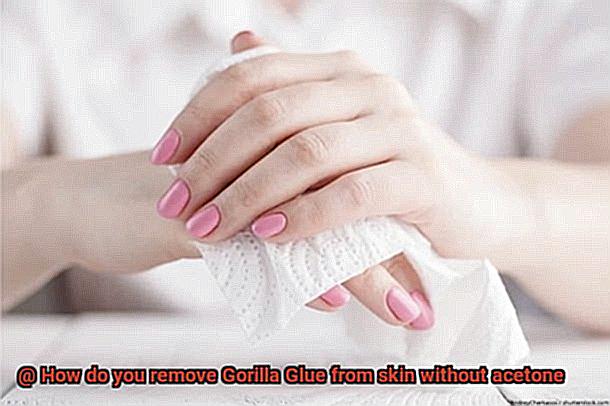
Lemon juice is known for its adhesive-removing properties and can be used as a natural remedy for Gorilla Glue removal. The acidic nature of lemon juice helps break down the glue bonds. Squeeze fresh lemon juice onto a cotton ball or directly onto the glue, ensuring that the affected area is completely saturated. Let it sit for a few minutes before attempting to remove the glue.
Vinegar is another effective natural remedy for removing Gorilla Glue from skin. Its acidic properties make it an excellent adhesive remover. Soak a cloth or cotton ball in vinegar and apply it directly to the glue. Allow it to sit for a few minutes before gently rubbing or peeling off the softened glue.
Coconut oil is yet another option that can be used as a natural remedy. It contains fatty acids that can help dissolve the adhesive properties of Gorilla Glue. Apply a generous amount of coconut oil to the affected area and let it sit for a few minutes. Gently massage the oil into the glue before attempting to remove it.
If you prefer a slightly stronger natural remedy, you can try using acetone-free nail polish remover. While most nail polish removers contain acetone, there are some brands available that are acetone-free. Apply a small amount of acetone-free nail polish remover to a cotton ball and dab it onto the glue. Gently rub or peel off the glue once it starts to loosen.
It’s important to note that while these natural remedies can be effective in removing Gorilla Glue from skin, they may not work as quickly or efficiently as using acetone. Additionally, for stubborn or dried Gorilla Glue, professional help or acetone-based products may be necessary for complete removal.
Tips for Safely Removing Gorilla Glue from Skin without Acetone
Removing Gorilla Glue from skin safely and without acetone is crucial due to the potential harm that acetone can cause to the skin. Harsh chemicals like acetone can irritate and damage the skin, making it essential to opt for alternative methods that are gentle and won’t harm your skin.
Using Warm, Soapy Water to Remove Gorilla Glue
To begin the process of removing Gorilla Glue from your skin, start by soaking the affected area in warm, soapy water for about 5-10 minutes. This step helps soften the glue, making it easier to remove. After soaking, use a soft cloth or sponge to gently scrub the glue. Be mindful of using mild pressure and avoid rubbing too vigorously to prevent skin irritation. Rinse the area with warm water and pat dry with a clean towel.
Using Oil-Based Products to Dissolve Gorilla Glue
If the glue remains stubbornly stuck, try using an oil-based product like baby oil or coconut oil. Apply a small amount of oil to a cotton ball or soft cloth and gently rub it over the glue until it starts to dissolve. The oil helps break down the adhesive. Rinse the area again with warm water and pat dry.
Using Petroleum Jelly or Petroleum-Based Ointments
For particularly stubborn glue, petroleum jelly or petroleum-based ointments can be effective. Apply a thick layer of petroleum jelly onto the glued area and let it sit for at least 15 minutes. The petroleum jelly will help soften the glue, making it easier to peel or gently rub off. Be patient during this process and repeat if necessary.
Moisturizing the Skin after Removing Gorilla Glue
After successfully removing the Gorilla Glue from your skin, it’s essential to thoroughly moisturize the area. The adhesive can leave your skin dry and irritated, so using a gentle moisturizer can help restore its natural balance and prevent any further discomfort.
Seeking Medical Attention for Sensitive Areas
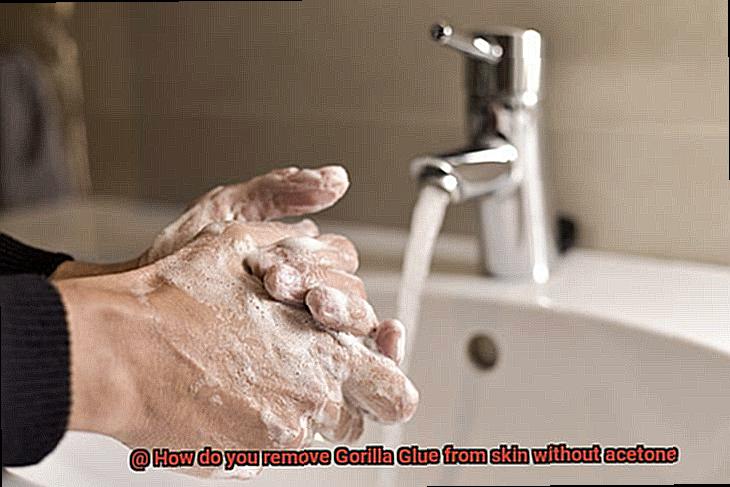
In case you accidentally get Gorilla Glue in your eyes, mouth, or other sensitive areas, it is crucial to seek immediate medical attention. These areas require professional care to ensure proper removal without causing harm or damage.
Prevention is Better than Cure
To avoid getting Gorilla Glue on your skin in the first place, it’s best to wear protective gloves and clothing when working with adhesives. Taking precautions can save you from the hassle of removing the glue later on.
When to Seek Professional Advice Regarding Removal of Gorilla Glue from Skin
When it comes to removing Gorilla Glue from skin, there are certain situations where seeking professional advice is necessary. Here are some key scenarios where it is advisable to consult a professional:
- Severe cases: If the Gorilla Glue has hardened or bonded deeply with the skin, it can be challenging to remove without causing further damage. In such cases, it is best to seek professional assistance to ensure safe and effective removal.
- Large affected area: If the glue covers a significant portion of the hand, face, or other sensitive areas, it is recommended to consult a professional. They have the expertise to handle these situations and can provide proper guidance on the removal process.
- Pain or irritation: If the Gorilla Glue is causing pain, irritation, or any other adverse reactions on the skin, seeking professional advice is crucial. They can assess the situation and provide appropriate treatment to alleviate discomfort and prevent further complications.
- Unsuccessful home removal attempts: If your attempts to remove the glue at home have been unsuccessful or have worsened the situation, it is time to consult a professional. They have the knowledge and tools to deal with adhesive-related issues effectively.
- Pre-existing skin conditions or allergies: Individuals with pre-existing skin conditions or allergies should always consult a healthcare professional before attempting any removal methods on their own. They can provide guidance tailored to your specific needs and help minimize any potential risks.
- Uncertainty about removal technique: If you are unsure about the appropriate removal technique for Gorilla Glue or have concerns about potential damage to the skin, seeking professional advice is highly recommended. They can provide expert guidance based on their experience and ensure safe and effective removal.
UDSer_BDGdM” >
Conclusion
Removing Gorilla Glue from skin without acetone can be a tricky task, but fear not, there are alternative methods that can come to your rescue. While acetone is often the go-to solution for removing adhesive substances, it may not always be readily available or suitable for use on skin. Fortunately, there are other options that can effectively dissolve and remove Gorilla Glue without causing harm to your skin.
One method you can try is using warm soapy water. Start by soaking the affected area in warm water for a few minutes to soften the glue. Then, gently scrub the area with soap using a soft cloth or sponge. The combination of warm water and soap can help break down the adhesive properties of the glue, making it easier to remove.
Another option is to use olive oil or coconut oil. These natural oils have properties that can help dissolve the glue without damaging your skin. Simply apply a generous amount of oil onto the affected area and let it sit for a few minutes. Then, gently rub the area in circular motions to loosen and remove the glue.
If you don’t have any oil on hand, you can also try using petroleum jelly or baby oil. Apply a thick layer of either substance onto the affected area and let it sit for several minutes. Then, using a soft cloth or sponge, gently rub the area in circular motions until the glue starts to lift off.
In some cases, rubbing alcohol or hand sanitizer can also be effective in removing Gorilla Glue from skin. These products contain alcohol which has solvent properties that can break down adhesives. Apply a small amount onto a cloth or cotton ball and gently dab it onto the affected area. Allow it to sit for a minute before wiping away the softened glue.
Remember to always be gentle when attempting to remove Gorilla Glue from your skin as excessive force or harsh chemicals may cause irritation or damage. If these methods do not work or if you experience any discomfort, it is best to seek professional advice or consult a healthcare professional.
In conclusion, while acetone may be the most commonly used solvent for removing Gorilla Glue from skin, there are alternative methods that can be just as effective.

